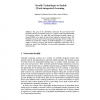1225 search results - page 236 / 245 » Design Principles for Intelligent Environments |
CORR
2011
Springer
12 years 11 months ago
2011
Springer
Imitation can be viewed as a means of enhancing learning in multiagent environments. It augments an agent’s ability to learn useful behaviors by making intelligent use of the kn...
IUI
2012
ACM
12 years 3 months ago
2012
ACM
The effort and time required to develop user interface models has been one of the main limitations to the adoption of model-based approaches, which enable intelligent processing o...
MOBICOM
2012
ACM
11 years 10 months ago
2012
ACM
In this paper, we propose a novel clock calibration approach called FLIGHT, which leverages the fact that the fluorescent light intensity changes with a stable period that equals...
CHI
2009
ACM
14 years 8 months ago
2009
ACM
Over the past few years, a quiet revolution has been redefining our fundamental computing technologies. Flexible E-Ink, OLED displays, shape-changing materials, parametric design,...
ECTEL
2007
Springer
14 years 1 months ago
2007
Springer
Abstract. The goal of the APOSDLE (Advanced Process-Oriented SelfDirected Learning environment) project is to support work-integrated learning of knowledge workers. We argue that w...

